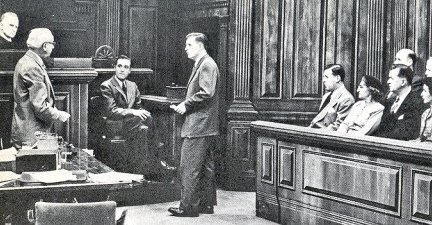
Scene
from "They Stand Accused"
Thursday, March 27, 2003
Page 14
REMINISCING (Column)
Courtroom Simulations Were Featured on Early Television
By ROGER M. GRACE
“Traffic Court” is the earliest courtroom re-creation show I remember. Hatched in 1957 as a local show on KABC, its success sparked production of copycat shows, both on network television, locally, and in syndication.
Those younger than I would think of Joseph Wapner’s “People’s Court” as the start of it all when it comes to courtroom simulations. On the other hand, those older than I, who had television sets in the early days of TV, might recall the seminal courtroom shows — shows which were quite like those that came later.
Even that first surge of “reality” courtroom TV shows in the late 1940s mimicked what had been on radio for years.
Today’s column is a “prequel” to a series of columns on “Traffic Court” and shows that followed it.
•“Famous Jury Trials” was a Du Mont offering which aired from Oct. 12, 1949-March 12, 1952. During part of that time, it was seen locally on KTSL, Channel 2. Courtroom scenes comprised most of the show.
Frankie Thomas, who had the lead role in “Tom Corbett, Space Cadet,” recalled “Famous Jury Trials” in a web interview:
“This was based on an earlier radio show, and the format established on the radio show created frenzy on TV. Here was the reason. The show opened in a courtroom with someone testifying, and faded out to a flashback of the events covered in the testimony. But of course the flashback involved the same actor or actress seen in the initial courtroom scene, and the problem was that the different sets were quite far apart in a large studio. The actors quickly became breathless running from set to set.”
At the end of the episode, viewers would be shown what had actually occurred.
The radio version was on the air from 1936-49. Actress Peggy Webber (who writes, directs and produces California Artists Radio Theater for National Public Radio) told me she appeared on the show fairly regularly around 1944. The program was recorded on disks, she noted, remarking that this “was unusual during the war years” when most shows were live. She related that the show was transcribed at the NBC studio, “but was recorded for ABC’s Blue network.”
•“They Stand Accused” began April 11, 1948 as a live, locally produced television show on WGN in Chicago, under the name “Cross Question.” It continued under that name after it went on the CBS network —or what there was of the CBS network then. On Jan. 18, 1949, a week after Chicago was linked by cable to New York, weekly transmissions of “Cross Question” to stations east of Chicago commenced.
|
|
|
|
WGN happened to be a Du Mont affiliate, and, not surprisingly, the show soon switched to the Du Mont network. It gained its new name in January, 1950.
I’ve found no indication that it was seen in L.A. during its initial run on Du Mont, from Sept. 11, 1949 to Oct. 5, 1952, but KHJ-TV, Channel 9, did carry it during the show’s revival from Sept. 9-Dec. 30, 1954.
The show was overseen by Illinois Assistant Attorney General William C. Wines. He devised the fact situation each week, and practicing lawyers would ad lib the proceedings—a format used on shows in the late 1950s, into the 1960s.
A jury, drawn from members of the audience, produced an instant verdict.
•“Your Witness” also emanated from Chicago. Featuring case reenactments, it was aired on ABC from Sept. 19, 1949 through Sept. 26, 1950. It starred Edmund Lowe, the son of a California judge. (He later appeared on Du Mont’s “Front Page Detective.”)
“Your Witness” was aired on ABC’s KECA-TV, Channel 7. It was nominated for a 1949 Emmy for best live program, losing to the “Ed Wynn Show.”
Locally, “You Be the Jury,” a drama, was aired by Channel 9 in 1950. Producer/director William Asher, associated with numerous network TV shows in the decades ahead (including “Bewitched”) worked on that show.
Copyright 2003, Metropolitan News Company